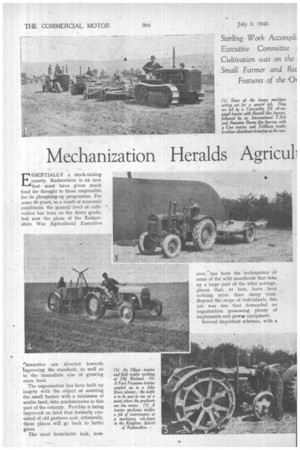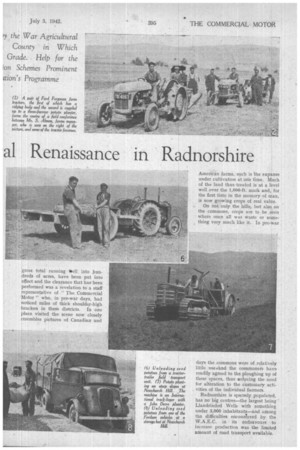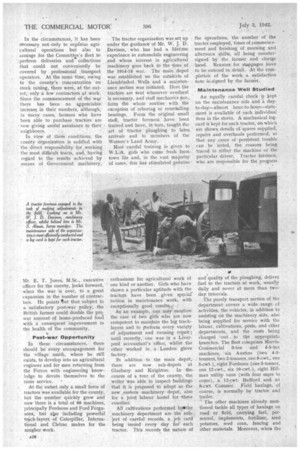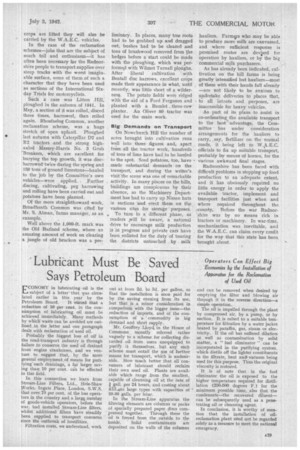Mechanization Heralds Agricull al Renaissance in Radnorshire
Page 26

Page 27

Page 28

Page 31

If you've noticed an error in this article please click here to report it so we can fix it.
SSENTIALLY a stock-raising county, Radnorshire is an area "that must have given much food for thought to those responsible for its ploughing-up programme. For some 3(1 years, as a result of economic conditions, the general level of cultivation has been on the down grade, but now the plans of the Radnorshire War Agricultural Executive r:ommittee are directed towards iMproving the standard, as well as to the immediate aim of growing more food.
The organization has been built up largely with the object of assisting the small farmer with a minimum of arable land, who predominates in this part of the country. Fertility is being improved on land that formerly consisted of old pastures and, ultimately, these places will go back to better grass.
The most formidable task, how ever,. has been the reclamation of some of the wild moorlands that take up a large part of the total acreage, places that, at best, have been nothing more than sheep -runs. Beyond the scope of individuals, this job was one that demanded an organization possessing plenty of implements and power equipment.
Several important schemes, with a gross total running *ell into hundreds of acres, have been put into effect and the clearance that has been performed was a revelation to a staff representative of " The Commercial Motor" who, in pre-war days, had noticed miles of thick shoulder-high bracken in these districts. rn one place visited the scene now closely resembles pictures of Canadian and American farms, such is the expanse under cultivation at one time. Much of the land thus treated is at a level well over the 1,000-ft. mark and, for the first tinie in the memory of man, is now growing crops of real value.
On not only the hills, but also on the commons, crops are to be seen where once all was waste or something very much like it. In pre-war days the commons were of relatively little usesand the commoners have readily agreed to the ploughing up of these spaces, thus seducing the need for alteration to the customary activities of the individual farmers.
Radnorshire is sparsely populated, has no big centres—the largest being Llandrindod Wells with something under 3,000 inhabitants—a.nd among the difficulties encounlered by the W.A.E.C. in its endeavours to increase production was the limited amount of road transport available. In the circumstances, it has been necessary not -only to. orgdnize 'agricultural operations but also to arrange for the Committee's fleet to perform deliveries and collections that -could not conveniently be covered by professional transport operators. At the same time, owing to the county's concentration on stock raising, there were, at the outset; only a few contractors at work. Since the commencement of the war there has been no a,ppreciable increase in their numbers, although, in many cases, farmers who have been able to purchase tractors are now giving useful assistance to their neighbours.
In view of these conditions, the county organization is saddled with the direct responsibility for working the most difficult tracts, and, having regard to the results achieved by means of Government machinery,
'Air. E. T. Jones., M.Sc., executive officer for the county, looks forward, when the war is over, to a great expansion in the number of contractors. He points tut that subject to a satisfactory post-war policy, the British farmer could double the prewar amount of home-produced focal with a consequent improvement in the health of the community.
Post-war Opportunity In these circumstances, there should be every encottragement for the village .smith, where he still exists, td develop into an agricultural engineer and for men returning from the Forces with engineering knowledge to devote themselves to the same service. '
At the 'outset only a small force of tractors was available for the county, but the number quickly grew and now there is a total of 88 machines, principally Fordsons and Ford Fergusons, but also including powerful track-layers of Caterpillar, International and Cletrac makes for the rougher Work. • The tractor organization was set up under the guidanc6r of Mr. W. J. D. Davison, who has had a lifetime. experience in automobile engineering and whose interest in agricultural machinery goes back to the time of the 1914-18 war. The main depot was established on the outskirts of Llandrindod Wells and a maintenance section was initiated. Here the tractors are tent whenever overhaul is necessary, and staff mechanics per-„, form Olt whole routine with the exception of reboring or remetalling bearings. From the original small staff, tractor foremen" have been trained and have, in turn, taught the art of tractor ploughing to later. arrivals and to members of the Women's Land Army.
Most careful training is given. to W.L.A. girls who come fresh from town life and, in the vast rnajority of cases, this hat stimulated genuine enthusiasm -for agricultural work of one kind or another. Girls who have shown a particular aptitude with the tractors have been . given specialtuition in maintenance work, with
exceptionally good results. .
As an example, one may mention the case of two girls who are now competent to maintain the big tracklayers and to perform every variety of adjustment and running repair; until recently, one was in a Liverpool accountant's office, whilst the other worked in a London glove factory.
In addition to the main depot, there are now sub-depots at Glasbury and Knighton. In the course of a tour of the county, the writer was able to inspect buildings that it is proposed to adopt as the new . eastern machinery depot, also for a joint labour hostel for three counties.
All cultivations performed byethe machinery department are the subject of careful records, a job card being issued every day col each tractor. This records the nature of the operations; the number of the tractor employed, times of commencement and finishing of morning and afternoon shifts, all being countersigned by the farmer and charge hand. Reasons for stoppages have to be entered in detail. At the completion of the work a satisfaction note is.signed by the farmer.
Maintenance Well Studied An equally careful check i,s 1.ept on the maintenance side and a dayto-day—almost hour-to-hour—statement is available of each individual item in the stores. A mechanical logcard is kept for each tractor, on. which are shown details ofspares supplied, repairs and overhauls performed, so that any cases of persistent trouble can be noted, the reasons being traced to either the machine or the particular driver. Tractor foremen, who are responsible for the progress and quality of the ploughing, deliver fuel to the tractors at work, usually daily and never at more than twoday intervals.
The purely transport section of the department covers a wide range c-f activities, the vehicles, in addition b assisting on the machinery side, also being supplied for service with the labour,. cultivations, pests, and other departments, and the costs being charged out . to the appropriate. branches. The fleet comprises MorrisCornmercial 3-ton and 4-5-ton machines, -six Austins (two 4-5tonners, two 2-tonners, one 8-cwt., one 5-cwt. ), eight Fordsons (one 3-tonner, one 12-cwt., six 10-cwt.), eight Hillman utility vans (with four more to come), a l2-cwt. Bedford and an 8-cwt. Commer. Field haulage, of course, is normally by tractor and trailer.
' The other machines already mentioned tackle all types of haulage on road or field, carrying fuel, personnel, implements, fertilizer, seed potatoes, seed corn, fencing and other materials. Moreover, when the crops are lifted they will also be carried by the W.A.E.C. vehicles.
In the case of the reclamation schemes—jobs that are the subject of much toil and enthusiasm—it has often been necessary for the Radnorshire people to transport supplies over steep tracks with the worst imagin, able surface, some of them of such a character that they have been used as sections of the International Sixday Trials for motorcyclists.
Such a case was Litton Hill, ploughed in the autumn of 1941. In May, a section of it was rolled, disced three times, harrowed, then rolled again. Rhosfaelog Common, another reclamation scheme, was a huge stretch of open upland. Ploughed last autumn with Caterpillar D2 and R2 tractors and the strong highaxled Massey-Harris No. 3 Grub -Breakers, which are excellent for burying the top growth, it was discharrowed twice during the spring and 159 tons of ground limestone—hauled to the job by the Committee's own vehicles—were applied. Further discing, cultivating, peg harrowing and rolling have been carried out and potatoes have been planted.
Of the more straightforward work, Broadheath Common was cited by Mr. S. Alman, farms manager, as an example.
Well above the 1,000-ft. mark was the Old Barland scheme, where an amazing amount of work on clearing a jungle of old bracken was a pre
liminary. In places, many tree roots had to be grubbed up and dragged out, bushes had to be cleared and tons of brushwood removed from the hedges before a start could be made with the ploughing, which was performed with Wilmot Turnall ploughs. After liberal cultivation with Bentall disc harrows, excellent crops made their appearance in what, until recently, was little short of a wilderness. The potato fields were ridged with the aid of a Ford Ferguson and planted with a Bamlet , three-row planter. An Oliver 80 tractor was used for the main work.
Big Demands on Transport • On Newchurch Hill the number of acres brought into cultivation runs Well into three figures and, apart from all the tractor work, hundreds of tons of lime have had to be hauled to the spot. Seed potatoes, too, have made substantial demands on the transport, and during the writer's visit the scene was one of•remarkable activity. In many places on the hills, buildings are conspicuous by their absence, so the Machinery Department has had to carry up Nissen huts in sections and erect them on the various sites for storage purposes.
• To turn to a different phase, aS readers will be aware, a national drive to encourage milk production is in progress and private cars have been enlisted for the duty of touring the districts untouched by milk hauliers. Farmvs who may be able to produce more milk are canvassed,, and where sufficient response is promised routes are devised for operation by hauliers, or by the big commercial milk purchasers.
As has already been indicated, cultivation on the hill farms is being greatly intensified but hauliers—most of them with their hands full already —are not likely to be anxious to undertake deliveries to places that, to all intents arid purposes, are inaccessible for heavy vehicles.
As part of its plans to assist in co-ordinating the available transport to the best' advantage, the Committee • has under consideration arrangements for the hauliers to carry, say, fertilizer on the normal roads, it being left to W.A.E.C. officials to fix up suitable transport, probably by means of horses, for the various awkward final stages.
Radnorshire has been faced with difficult problems in stepping up food production to an adequate extent, and it has obviously required no little energy in order to apply the available tractor, implement and transport facilities just when and where required throughout the 'county, Before the war RadnorAire was by no gleans rich in tractors or machinery. In war-time, mechanization was inevitable, and the W.A.E.C. can claim every credit for the way that this state has been brought about.




















































